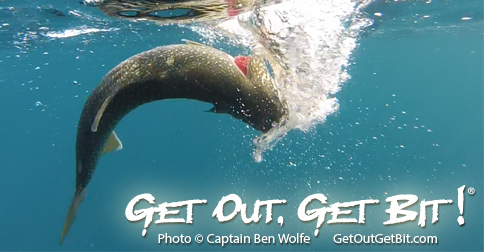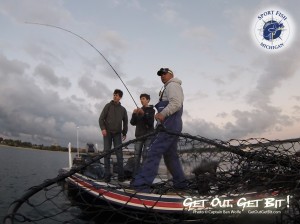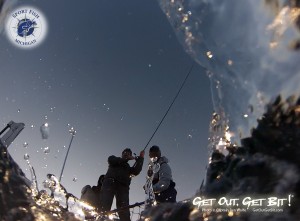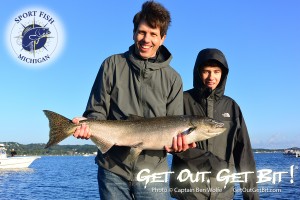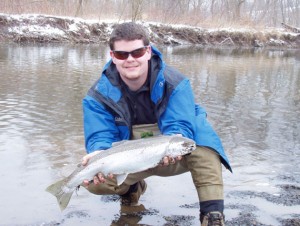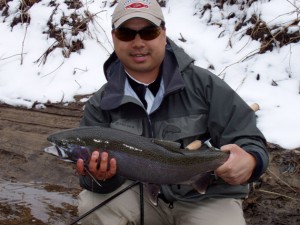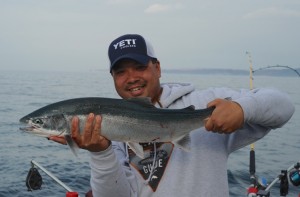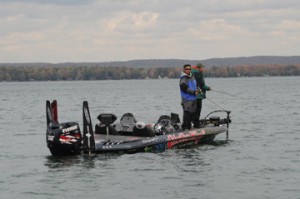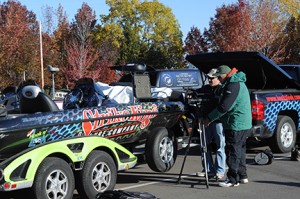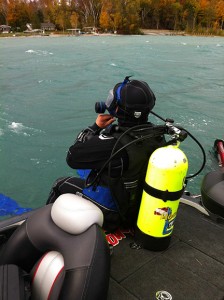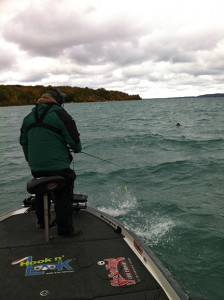Captains Ben Wolfe and Eric Long enjoy a fun and successful day of Walleye fishing on the St. Clair River in Michigan.
Category Archives: Fishing Trips
Salmon Jigging Fun in Northern Michigan
Vertical jigging for salmon in northern Michigan is fun and exciting! Book your hands-on, light tackle, vertical jigging trip with Sport Fish Michigan to experience the best Michigan fishing.
Jika Rig Tip – Smallmouth Bass Fishing
Capt. Ben Wolfe shares tips for setting up and using a Jika rig for bass fishing. This fishing rig can increase casting accuracy and allow anglers to more easily feel the rig moving through the water and along the bottom.
Vertical Jigging Basics for Salmon, Lake Trout, and Whitefish
Vertical jigging for salmon, lake trout, and whitefish can be as simple, or as complicated, as we want to make it as anglers. There are some very definite things that I think set apart those anglers which generally do well day-in and day-out overall, and those that hope to get lucky out on the water. Certainly, fish are fish, and every day is a learning experience that can be humbling.
Here are a few basic things that I feel are critical to understand for increased success when out on the water using a technique like vertical jigging.
Equipment:
Rods—Rods used for vertical jigging traditionally fall into 2 categories—small, short ice fishing style rods, or longer bass fishing style rods. There are pros and cons to each.
Personally, I use medium or medium-heavy bass rods for my vertical jigging needs. I like the additional length of a 6 -7 foot bass rod because I can move a lot of line on a hook set, while I still have the ability of making jigging motions as small or as large as I like. Some days, a jigging motion needs to be very small, but many days, the preferred jigging motion is larger, meant to really trigger an aggressive response from salmon and lake trout. I also feel that a longer rod is better able to cushion the hard tugs and pulls of lake trout and salmon. This way, the rod can fight the fish, not just the line.
Stout ice fishing rods are small and mighty, and really lend themselves well to a smaller jigging motion, as sometimes is necessary to trigger finicky fish. Whitefish tend to like much less action, and these rods make it hard for anglers to over-work a jig. While this is a plus, the big negative side to this style of rod is that an angler can move much less line on a hook set when a fish eats a jig as it comes up in the water column. I have missed many more fish with shorter ice rods than I have with longer bass rods, unless the fish hook themselves. There is a large following of dedicated jiggers that swear by this style of rod, but my preference lies with the longer bass style rod.
Reels—Fishing reels are kind of a no-brainer. Baitcasting reels paired with a baitcasting rod are my personal preference for jigging, but spinning rods also have a time and place. When paired with the proper rod, either spinning or baitcasting is a great option. I like to use the smaller bass size reels, as they get less tiring to use over a long day of jigging. Line capacity is often misunderstood, as most bass reels can easily handle 100-150 yards of line. That’s 300-450 feet of line! Considering that most jigging situations are in 150 feet of depth or less, there is more than double the capacity needed to jig and fight fish.
Lines—I always prefer braided line for jigging, tied to a fluorocarbon leader of about 6 feet or so. I typically use 15 pound Power Pro line which, over the years, has proven itself time and time again. Braided line fishes well even when twisted, unlike straight monofilament or fluorocarbon. Braided lines also offer a huge advantage in sensitivity—something that is needed to help detect the bottom when it’s windy or wavy out. Braided line also helps to get a good hookset when fishing in depths over 30 feet. With almost zero stretch, braid gets the hook penetrated almost immediately when the hook is set, as opposed to monofilament which has almost a 40% stretch factor. With a limber bass rod, braided lines won’t pull out of a fish’s mouth as many would believe, because the rod cushions the line. Fluorocarbon leaders are a must in our clear water, as fish can be line shy, even at depths of 100 or more feet. Fluorocarbon has the same refractive index as water, and is nearly invisible underwater. I prefer a 6 foot section tied directly to my braided line. Another added bonus of fluorocarbon is that it is much more sensitive and has much less stretch than monofilament. With braid as my main line, and a fluorocarbon leader, I am now ready to jig.
Jigs:
Jigs used for vertical jigging are as varied, and they all have their time and place. While each may trigger bites on any given day, there are a few basic things to understand within the jig category. How a jig falls, and the action that it gives when jigged, can have everything to do with how well a day can go on the water. Having a variety of jigs on the boat, and an open mind about experimenting, can really help to boat more fish. Also equally important can be jig weight. How quickly a jig falls can also play a large role in triggering bites, or going unnoticed and ignored. I prefer jigs anywhere from 1-3 ounces for lake trout and salmon. When vertical jigging a species like burbot or whitefish, smaller jigs can be the ticket. For these fish, I prefer jigs in the ½-1 ounce range.
I almost always use either a snap swivel or a line snap to attach my jigs. I nearly never tie directly to the jig when I am using treble hooks. However, when using jigs that have a single free-swinging assist-style hook, I will tie directly to the split ring, as these baits were intended.
Flutter / Butterfly style—this is a style of jig that is most commonly used in saltwater. These style jigs usually have a horizontal flutter fall, but within this category, there are differences in the upward motion. Some pull straight upwards when jigged. Others have a side-to-side flutter when pulled up in the water column – Jonah Jigs is a prime example of this style of jig, as are Shimano Butterfly jigs.
Corkscrew fall style—these style jigs are also often used in saltwater, and have a spiral action as they fall. Different species of fish seem to like these falls better. Lake trout and salmon often prefer a flutter style of fall in the water, but there are days when a corkscrew fall is the only way to trigger bites. The Shimano Coltsniper is an example of this style of jig. Swedish Pimples fall into both the flutter and corkscrew style categories, since jigging motion can create both actions.
Shad style—These style of jigs are more football shaped, more closely mimicking a shad body. They have action on the fall as well as a tight vibration on the up-jig motion. These baits work wonders when there is a big shad or alewife population that fish feed on, and here in the Great Lakes, alewives are a staple for salmon and lake trout.
S-shape style—This category of jigs has a slight bend in them, resembling a softly-curved letter "S". The bend in these jigs promotes a lot of water displacement both on the jigging motion up, and the fall of the jig. This not only produces an erratic action, it also has a lot of vibration, which can really help to bring fish in from a distance. BBM and Elk Rapids jigs are options for Great Lakes anglers. Jonah Jigs and PLine jigs can be bent to create an "S" shape, altering both the fall rate and action.
Do nothing style jigs—this is a style of jig that is most commonly used when the water is very cold. BBM makes a jig called a sand kicker. This jig does nothing, but jig up and down, with no side to side or fluttering action. Lake trout, whitefish, and burbot love these jigs when the water is cold, and they are often used by ice fishing anglers. Here, it is critical to tie the fluorocarbon directly to the jig without the use of a snap or swivel.
Bites:
Bites from salmon and lake trout can be varied, despite an aggressive nature overall. Understanding the different types of bites can help to land several more fish over the course of a day on the water.
On the fall/drop—Lake trout and salmon like to hit on the drop, as the jig is still falling through the water column. Bites on the fall can, themselves, be split into two distinct categories. First are the bites that occur as the rod is moving downward, following the jig on the fall. The bite occurs, and the rod is jerked down aggressively. An immediate hook set upwards is the way stick these bites.
The second way salmon and trout bite requires attention being paid by the angler. It’s not uncommon for a laker or a salmon to swim up in the water column to grab the jig, putting slack into the line. Anglers should be aware of how far they are lifting and dropping their jig, and should the jig not fall as far as it should, this is a sure sign that a fish has it, and a big hookset while reeling like crazy can often times stick these aggressive biters. A common telltale is a pile of line on the surface instead of a semi-taught line as the jig falls. This happens multiple times throughout most guide days, and the anglers that notice this are quite often rewarded with a fish that may otherwise have gotten away – the jig spat out quickly.
On the uplift—it’s not uncommon for bites to occur on the uplift of a jigging stroke. An angler is lifting the rod, and all of a sudden, there’s slack in the line when the weight of the jig should be keeping the line tight. A quick hook set is the only way to stick these fish, and a longer bass style fishing rod is critical here, due to the added ability to move line quickly.
Jigging away—When using good sonar units to mark fish, it is common to see our jigs fall towards fish. One way to trigger a reaction strike from lake trout and salmon is to mimic a fleeing baitfish. In order to get this kind of response, a jig can be jigged up and away from fish to trigger bites. A quick jig, reel several cranks, another quick jig, followed by more cranks of the reel is the most common method used to trigger these powerful reaction strikes. Another alternative form to get fish to chase a jig, is to just reel quickly away from fish that are known to be in the area. It’s fairly common to hook a fish reeling quickly when another angler on the boat has a fish on, and the angler is simply reeling up to get their line out of the way. On a recent trip, I had a fish chase my jig all the way to the boat from 87 feet of water, trying to eat the jig even as it came out of the water! Had I known I had a chaser, I would have slowed down just a smidge, to give the fish time to eat, but since I was focused on getting the net for my customer, I had no idea that I had an aggressive lake trout chasing my jig.
Boat control:
Boat control is critical in the sense that we need to understand how we are going to fish. Do we need the boat to hold in a specific spot because we want to fish a particular depth or contour break line, or do we intend to drift a flat covering lots of water looking for active fish?. To further discuss boat control means to break down into two categories how we intend to present our jigs.
For salmon and lake trout in particular, jigs should often be close to the bottom, if not occasionally bumping the bottom. If we intend to drift with the wind, we can use a motor, whether it is an electric trolling motor or a kicker motor, to hold the boat in a particular depth as we drift along. Using a drift sock can greatly slow the rate of drift, very often enabling us to feel the bottom. Drifting too quickly pulls the jigs away from the bottom, and more and more line must be let out to continually stay in contact with where the bottom is, and where the fish mostly hold. For this technique, boat speed is the crucial aspect that will help success rates.
For vertical jigging, the more vertical our presentation, the better our success when fishing a specific depth or contour break line. To hold in a particular spot, depth, or contour, I prefer the use of an electric trolling motor to accomplish the task, but a kicker motor put in and out of gear is a perfectly acceptable alternative. While holding on a spot, it is also possible to cast jigs out away from the boat, let them fall and jig them back with great results.
No coffee needed!
It’s a pleasure fishing with customers who book with Traverse City Bass Guide Service. I enjoy meeting new people and sharing in their special day on the water as we fish for smallmouth bass on the beautiful world-class waters of Grand Traverse Bays. Occasionally, opportunities that don’t involve bass fishing present themselves that I love to pass along to my customers.
Such an opportunity presented itself several days ago when there was a hard north wind for a couple of days in northern Michigan. Late summer typically means that salmon will make their way close to river mouths where they will run upstream to spawn. A hard north wind will often stack the salmon up in thick numbers, making them easy for boats not outfitted for trolling, such as a bass boat, to use techniques other than trolling to cast to, and catch, these awesomely powerful fish.
In Traverse City, the Boardman River empties into West Bay. Adjacent to this river mouth is deep water, known as “the hole.” Salmon congregate in large numbers in the hole, bringing with them a set of opportunities for catching them that doesn’t have to mean trolling from a large charter boat. While trolling this is a terrific technique enjoyed by many, others prefer a more hands-on approach. I am definitely one of those-enjoying the challenge and adrenaline rush of catching salmon with rod and reel in-hand.
A few days prior to my bass trip with a couple of new customers, when I typically contact my customers, I knew that there would be an opportunity to vertical jig for king salmon in “the hole.” My customer, Michael, seeking a thrill for himself and for his son, readily agreed that targeting salmon would be an interesting alternative to bass fishing. We agreed to meet in the pre-dawn hours, getting out early trying to hopefully take advantage of the first light bite.
Early morning fishing requires caffeine if you’re me. In fact, for me, every day requires coffee-especially if you own a coffee company, which I do. Deep Blue Coffee Company supplies coffee to Traverse City Bass for its customers to enjoy during their trip, often eliminating a customer’s suffering through hotel coffee. They get to show up at the boat ramp, and I’ll have a great cup of coffee waiting for them.
This day, I somehow forgot the coffee carafe, and sent my customer a text that I had dropped the ball and forgotten the coffee. “No worries,” he said, “I don’t drink that much coffee anyway.” Nevertheless, I felt terrible about my oversight.
We launched the boat in the pre-dawn darkness, and headed down towards the hole in hopes of being able to hook up with some salmon by jigging Jonah Jigs, which were designed specifically for vertical jigging salmon. Armed with my G.Loomis jigging rods, we were rigged and ready for business! After showing my customer and his 13-year-old son the proper techniques for jigging, we began our day by looking for schools of salmon on my sonar. Bingo, there they were!!! “OK, drop guys!” By dropping our Jonah Jigs to the bottom and reeling up to the depth that the salmon were holding in I knew that we were in a good position to hopefully get bit in short order.
It wasn’t long before I felt the telltale aggressive jolt from a salmon, but didn’t hook up. Shortly after my bite, Michael also got a bite, stopping his heart for a moment. “You weren’t kidding when you said that this was an aggressive bite!” Now we were on to something. No sooner had he finished sharing his experience about the sensation of the bite, he was hooked up, with drag peeling off of my Shimano reel. “Holy **Bleep**!” he shouted, “NO COFFEE NEEDED!!! THIS IS AWESOME!” After a 5-minute battle full of drag pulling and powerful thrashing on the surface, our king salmon was in the net, coming aboard for some photos. Perfectly hooked right in the jaw.
I’m pleased to say that we were able to boat 4 salmon, out of the 7 that we hooked up with. We had numerous other bites, including a dandy lake trout that Michael’s son, Justin landed. The entire time, Michael kept saying how exciting it was to catch a salmon with a technique that allowed him to feel the bite and fight the fish all on his own. It was a fantastic morning of fishing, and the added benefit was that they were able to take their catch home, something that we don’t allow when we bass fish. As a guide, it’s gratifying knowing that my customers had a day that far exceeded their expectations. And to be able to take advantage of a unique set of opportunities made it all that much more special. We can’t always jig for salmon, but when the circumstances present themselves…. Good things can happen!
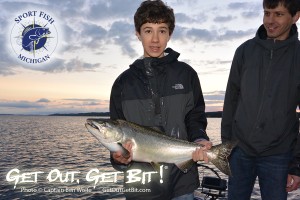
Wolfe Outfitters Welcomes Crystal Mountain Guests
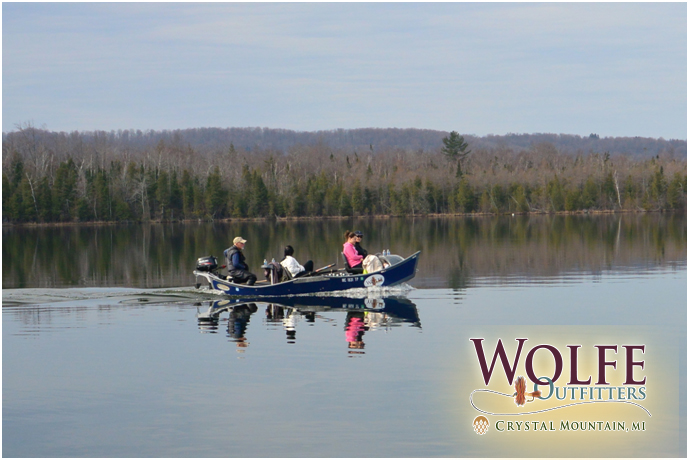
Lisa, Michelle, and Willow off for their fishing adventure with Wolfe Outfitters guide Bear Andrews.
Crystal Mountain recently had a weekend dedicated to its property owners—those families that own condos or rooms at this 4-season resort. Wolfe Outfitters, a joint venture with Crystal Mountain had our formal introduction to the property owners, and we hosted the Fiesta Night cocktail party.
We were fortunate to have a great turnout for the event, with over 200 people having signed up to attend. Wolfe Outfitters had a couple of tables that we set up with various fly boxes, fly tying materials, fly reels, rods, nets, rack cards, banners and, of course, lots of Wolfe Outfitters swag to give away! Decals, Simms thirsty trout bottle opener key-chains with our logo, beer koozies, and some shirts and hats.
We worked with Simms Fishing Products to get our logo onto a few sweet looking shirts and hats as well. The dye-sublimated Ebb-tide shirts, DeYoung artist series shirts, and Solarflex shirts all came out looking awesome. They look really sharp, and should look great on and off the water.
We generated quite a bit of interest from various property owners, getting to know many of them, as we chatted about the resort as well as about fishing! We had 4 of our guides there, plus a few of the resort staff to help answer questions, lend a hand, and even book trips for people.
Our head fly guide, Jeff “Bear” Andrews, did a special fly tying demo, tying up numerous flies in an effortless way that drew quite a crowd of onlookers. Or, it could have been the kilt that he was wearing in honor of the event and the Crystal Mountain owner’s heritage! Either way—kilt or fly tying demonstration—there was quite a crowd.
The last highlight of the evening was a raffle for more free swag and a trip giveaway. Cheers went up as the winners of shirts, hats, fly boxes were announced, but there was a definite tension in the air as everybody awaited the announcement of the lucky guided trip winner. Wouldn’t you know, the winners of the trip were not the many avid anglers in the crowd, but 3 giddy women, who were on a girls getaway weekend together! They were looking for something new to experience together, and were contemplating booking a trip, but decided to enter the raffle first to see if they’d win. Of the huge net-full of raffle entries, who’d have thought!
Making a Case for Winter Steelhead Fishing
During the cold winter months, it’s down right cold, and the motivation to head out of a warm house to go fishing is difficult to say the least. Two of my guide services are still in operation during these cold winter months—Manistee River Salmon Guide Service and Wolfe Outfitters, and we’re happy to brave the cold with our customers. Sure, motivation for us to leave the comfort of our homes and trucks is tough too, but usually once we’re out on the water casting, enjoying the day with our customers, things don’t feel as cold.
Despite the chilly temperatures, the Big Manistee River doesn’t usually freeze over due to its big flow, and there is often fishable water for the beautiful steelhead all winter long. And one of the most enjoyable things about winter steelhead fishing is the relative lack of fishing pressure. It’s not uncommon to go all day without seeing another angler. The quiet solitude of winter fishing is a true joy, and most customers are thrilled to see the river without much other fishing pressure. And the fishing can be absolutely hot, even if the temperatures are cold.
Many a snowy day have we experienced tremendous fishing for steelhead on the Manistee River and other area rivers. Not only does the sight of a chrome steelhead warm the blood, battling these acrobatic fish also gets the body moving, and the adrenaline up. During the dead of winter, steelhead don’t maybe jump as frequently as during the fall, but they still jump and run, thrilling anglers of all ages.
Manistee River Salmon Guide Service is suited with a custom jet sled that can utilize much of the river, searching for active fish. And with my USCG Captain’s license, I can legally fish my customers in the lowest stretches of the river, where some fish tend to hold in the deep, slow pools.
A plus for the Wolfe Outfitters guide service is that it is based out of Crystal Mountain Resort. This makes for a comfortable retreat after a cold winter’s day of fishing. Spa services, a heated pool and a couple of nice restaurants are just some of the more pampering amenities offered by Crystal Mountain Resort. Not to mention that it’s a fantastic ski resort as well! There are lots of ski runs catering to both downhill skiers and groomed runs for cross-country skiers. What a great way to combine either a fishing and skiing trip with the guys, or pile the family into the comfortable rooms for a winter get-away! Crystal Mountain Resort has just about everything on-site, and is done in a first class and stunning fashion. We are proud to have partnered Wolfe Outfitters with a resort like Crystal Mountain Resort.
Just because the weather has turned chilly doesn’t mean that the fishing has cooled down. Come and experience the hot steelhead action that’s available in northern Michigan!
Aaron with a beautiful steelhead hen that we caught while wading.
Winter steelhead action can be downright hot!
October Steelhead on Lake Michigan
Just because you can’t go doesn’t mean that I’m not going to go. This scenario happened several days ago when one of my Sport Fish Michigan Captains, Andy Odette and I went out for a few hours of fun fishing after a 3 boat trip cancelled.
With extremely rough seas predicted for the actual scheduled day, I tried to see if the party of 17 was able to switch days to a day earlier in order to take advantage of the calm Indian Summer afternoon that we were experiencing here in northern Michigan. Here for a corporate retreat, the party of 17 initially seemed interested in switching afternoons to take advantage of the calm weather, but ultimately were unable to do so.
Disappointed in not being able to showcase the awesome late October bite that the Frankfort area provides to our 17 person party, Captain Andy and I decided to not waste the afternoon by not heading out for a couple of hours just for fun. Joined by another one of the Captains that would have been a part of the 3-boat trip, we headed out onto the near-pancake flat waters of Lake Michigan.
Using a variety of presentations, trying to take advantage of the upper water-column feeding that steelhead are notorious for, we put out multiple options in the top 15 feet. Steelhead are partial to orange, and our spreads included a lot of oranges, oranges and blacks, oranges and chrome and oranges and greens. Although we missed our first steelhead bite on a planer board, we knew we were onto something, having only had a line in the water for 10 minutes or so.
Despite the variety of presentations that we were using, only 2 seemed to be getting the bulk of the attention. Sure, we got a nice steelhead on a downrigger, set 12 feet down, and got a couple of bites on a few other spoons, but interestingly, it was 2 of the more unexpected presentations that seemed to catch the most fish. One was a plain chrome spoon that had all of the paint knocked off, and the other was a tiny little casting spoon in a perch pattern. The go-to spoons yielded nothing. All this goes to show is how effective trolling a large variety spread can be when trying to refine a pattern, and also how unpredictable fish can be. What we thought would work didn’t. What we as anglers were indifferent about, turned out to be the key, with the fish responding very well.
In all, we landed our limit of steelhead in short order, and adjusted our presentations to target 3-year-old king salmon, which we were seeing on our electronics. It was a true pleasure to be able to get out for a couple of hours to just “fun fish”. It was a shame that our 3 boat trip had to cancel, and couldn’t take advantage of the wonderfully pleasant conditions, but such is the case. Just because they couldn’t go didn’t mean that we couldn’t! A couple of productive hours out on the water catching fall steelhead certainly beats sitting at the dock dreaming!
Hook N’ Look
What a difference a couple of weeks can make! 3 weeks ago, I was thrilled to film a tv show, Hook N’ Look over the course of 3 days with Kim and Danny Stricker. The weather was crappy—heavy winds all 3 days, and rain for two of them. Perfect for showing off raingear, but difficult to film in, considering the high-definition cameras and sensitive microphones. Sure, the fish are already wet, and we’re in a boat designed for water, but wow was it uncomfortable. Thank goodness we were also highlighting my coffee company, Deep Blue Coffee. Few things can warm up a chilly and wet day on the water than a great cup of hot coffee!
Filming a spinnerbait show, showcasing the Strike King tour grade painted blade spinnerbaits, we needed wind to help promote a hot bass bite. Well, we got wind—a little too much of it, however. We were able to connect on a few, and got a few more to chase and bump the spinnerbait, but overall, it was not a great bite to really show off this technique. As a full time guide, this was a little puzzling. The fish were shallow; there was the right water temperature zone; there was wind to help promote a shallow spinnerbait bite; and there were baitfish present. All signs that there should have been a phenomenal spinnerbait bite.
The fish, however, don’t always seem to follow our human best laid plans. And very often, in very frustrating fashion, they do their own thing. Given the seemingly perfect conditions for this kind of bite, it became very apparent that we would have to grind it out, taking an overly persistent mindset. Having confidence in an area was key for our shoot. I knew from years of experience where the fish were. Just getting them to bite on what we wanted them to bite on, for the sake of a spinnerbait show was the issue. Sure we probably could have gotten more bites using other baits or techniques, but if you’re going to film a spinnerbait show—you have to throw a spinnerbait! Not having confidence in the areas we were fishing could have led us all over northern Michigan’s prime smallmouth water, but at the end of the day—if you know the fish are there—don’t leave fish to find fish. Just fish, and make it happen.
In all, filming with Hook N’ Look was a great experience. Kim, Danny and my friend Capt. Kyle Buck (who was driving my Ranger Z-520 as the camera boat) all shared a lot of laughs, caught some fish, filmed a show, and drank A LOT of Deep Blue Coffee Company’s coffee. Would I do it again? In a heartbeat!
“Hook N’ Look”
It was a distinct pleasure to have Traverse City Bass Guide Service film a television show this past week. Conditions were extremely tough, but we figured out a way to make something work. Kim Stricker and his son, Danny, came up to film for their show “Hook N’ Look” with me at Traverse City Bass. I’ve known Kim for a couple years, and we chatted for a while earlier this year at the East Bay boat launch in Traverse City. At the time, we discussed possibly filming a fall show, highlighting the aggressive nature of fall smallies by doing a spinnerbait show highlighting the Tour Grade spinnerbaits made by Strike King.
It was truly wonderful to welcome my friend back up to northern Michigan to film for his show. We had already delayed the shoot by several days due to bad weather, and unfortunately this time, it looked as if we were going to have to just shut up and fish (and film).
Naturally, all of the best planning in the world can’t account for Mother Nature’s ultimate decisions. Cold, windy, rainy conditions meant we were going to be filming in cold, windy, rainy, rough weather. I was pumped—I knew there would be some fish up in the mid shallows, and with the wind, this was going to be perfect for a Strike King spinnerbait show.
A few days prior, I contacted one of my other Sport Fish Michigan Captains to operate my own bass boat, which would function as the camera chase boat. Captain Kyle Buck drove up from Muskegon to be my camera boat driver. There were a couple of closer choices that I could have used within my network of Sport Fish Michigan network of Captains and Guides, but Kyle has a long history with foot-controlled trolling motors, and operating bass boats. Prior to becoming a licensed Captain, Kyle fished nationally in bass tournaments.
Originally scheduled for a 2 day shoot, yet hoping to accomplish everything in 1 day, we all met for breakfast on day one and talked strategy, weather, and shot the breeze for a while, letting the sun get up to warm things a bit. It was a chilly 37 degrees when we met that morning. Again, the best laid plans are sometimes ignored by Mother Nature. Our 2-day shoot turned into a 3-day shoot, as we fought the weather tooth and nail, trying to get the shots and video needed.
Having great outdoor gear is important, and for a time like this, it’s just as crucial. Not wanting to look like a total marshmallow or the Michelin Man, I opted for my Simms Fishing Products long underwear underneath regular clothes and my Simms Pro Dry bibs and parka. And naturally, I wore my Traverse City Bass hooded sweatshirt for good luck!





